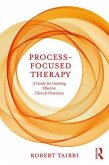- Broschiertes Buch
- Merkliste
- Auf die Merkliste
- Bewerten Bewerten
- Teilen
- Produkt teilen
- Produkterinnerung
- Produkterinnerung
In his extensive description of the heuristic approach to psychoanalytic therapy, Peterfreund discusses the strategies used by both patient and therapist as they move toward discovery and deeper understanding.
Andere Kunden interessierten sich auch für
![Elements of the Helping Process Elements of the Helping Process]() Raymond FoxElements of the Helping Process75,99 €
Raymond FoxElements of the Helping Process75,99 €![The Performing Art of Therapy The Performing Art of Therapy]() Mark O'ConnellThe Performing Art of Therapy50,99 €
Mark O'ConnellThe Performing Art of Therapy50,99 €![Process-Focused Therapy Process-Focused Therapy]() Robert TaibbiProcess-Focused Therapy50,99 €
Robert TaibbiProcess-Focused Therapy50,99 €![Primary Process Impacts and Dreaming the Undreamable Object in the Work of Michael Eigen Primary Process Impacts and Dreaming the Undreamable Object in the Work of Michael Eigen]() Primary Process Impacts and Dreaming the Undreamable Object in the Work of Michael Eigen162,99 €
Primary Process Impacts and Dreaming the Undreamable Object in the Work of Michael Eigen162,99 €![The Art of Strategic Therapy The Art of Strategic Therapy]() Jay HaleyThe Art of Strategic Therapy66,99 €
Jay HaleyThe Art of Strategic Therapy66,99 €![Body Words and the Analyst's Use of Self Body Words and the Analyst's Use of Self]() Barbara PizerBody Words and the Analyst's Use of Self163,99 €
Barbara PizerBody Words and the Analyst's Use of Self163,99 €![Defense Mechanisms in the Counseling Process Defense Mechanisms in the Counseling Process]() Arthur J. ClarkDefense Mechanisms in the Counseling Process172,99 €
Arthur J. ClarkDefense Mechanisms in the Counseling Process172,99 €-
-
-
In his extensive description of the heuristic approach to psychoanalytic therapy, Peterfreund discusses the strategies used by both patient and therapist as they move toward discovery and deeper understanding.
Produktdetails
- Produktdetails
- Verlag: Routledge
- Seitenzahl: 284
- Erscheinungstermin: 20. März 2019
- Englisch
- Abmessung: 229mm x 152mm x 15mm
- Gewicht: 416g
- ISBN-13: 9781138872059
- ISBN-10: 1138872059
- Artikelnr.: 42804592
- Herstellerkennzeichnung
- Libri GmbH
- Europaallee 1
- 36244 Bad Hersfeld
- gpsr@libri.de
- Verlag: Routledge
- Seitenzahl: 284
- Erscheinungstermin: 20. März 2019
- Englisch
- Abmessung: 229mm x 152mm x 15mm
- Gewicht: 416g
- ISBN-13: 9781138872059
- ISBN-10: 1138872059
- Artikelnr.: 42804592
- Herstellerkennzeichnung
- Libri GmbH
- Europaallee 1
- 36244 Bad Hersfeld
- gpsr@libri.de
Emanuel Peterfreumd, a graduate of the University of Chicago School of Medicine, was trained in psychiatry and psychoanalysis in New York City. He is a member of the New York Psychoanalytic Society and is Associate Clinical Professor of Psychiatry at the Mount Sinai School of Medicine. He is the author of Information, Systems, and Psychoanalysis as well as numerous articles on clinical and theoretical issues.
I. Stereotyped Approaches to Psychoanalytic Therapy 1. Stereotyped
Approaches: Examples from Personal Experience 2. Stereotyped Approaches:
Examples from the Literature 3. General Characteristics of Stereotyped
Approaches II. A Heuristic Approach to Psychoanalytic Therapy 4.
Psychoanalytic Therapy as Heuristic Process 5. The Concept of Heuristic
Strategies 6. The Concept of Working Models 7. Working Models in
Communication Processes and in Psychoanalytic Therapy III. Case
Illustrations of the Heuristic Approach 8. Case of Mrs. C 9. Case of Mrs.
D 10. Case of Mr. E 11. Case of Mr. F 12. Case of Mr. G IV. Strategies
Used in the Therapeutic Process 13. Strategies of the Analyst: General
Strategies 14. Strategies of the Analyst: The Analyst as Participant
Observer 15. Strategies of the Analyst: The Patient as Participant in the
Therapeutic Process 16. Strategies of the Analyst: The Establishment of
Meanings 17. Strategies Used by the Patient 18. Some General
Characteristics of Heuristic Analytic Sessions V. Evidence, Explanation,
and Effectiveness 19. Evidence and Explanation in Psychoanalytic Therapy
20. Evaluating the Effectiveness of Psychoanalytic Therapy 21. What Makes
Psychoanalytic Therapy Effective?
Approaches: Examples from Personal Experience 2. Stereotyped Approaches:
Examples from the Literature 3. General Characteristics of Stereotyped
Approaches II. A Heuristic Approach to Psychoanalytic Therapy 4.
Psychoanalytic Therapy as Heuristic Process 5. The Concept of Heuristic
Strategies 6. The Concept of Working Models 7. Working Models in
Communication Processes and in Psychoanalytic Therapy III. Case
Illustrations of the Heuristic Approach 8. Case of Mrs. C 9. Case of Mrs.
D 10. Case of Mr. E 11. Case of Mr. F 12. Case of Mr. G IV. Strategies
Used in the Therapeutic Process 13. Strategies of the Analyst: General
Strategies 14. Strategies of the Analyst: The Analyst as Participant
Observer 15. Strategies of the Analyst: The Patient as Participant in the
Therapeutic Process 16. Strategies of the Analyst: The Establishment of
Meanings 17. Strategies Used by the Patient 18. Some General
Characteristics of Heuristic Analytic Sessions V. Evidence, Explanation,
and Effectiveness 19. Evidence and Explanation in Psychoanalytic Therapy
20. Evaluating the Effectiveness of Psychoanalytic Therapy 21. What Makes
Psychoanalytic Therapy Effective?
I. Stereotyped Approaches to Psychoanalytic Therapy 1. Stereotyped
Approaches: Examples from Personal Experience 2. Stereotyped Approaches:
Examples from the Literature 3. General Characteristics of Stereotyped
Approaches II. A Heuristic Approach to Psychoanalytic Therapy 4.
Psychoanalytic Therapy as Heuristic Process 5. The Concept of Heuristic
Strategies 6. The Concept of Working Models 7. Working Models in
Communication Processes and in Psychoanalytic Therapy III. Case
Illustrations of the Heuristic Approach 8. Case of Mrs. C 9. Case of Mrs.
D 10. Case of Mr. E 11. Case of Mr. F 12. Case of Mr. G IV. Strategies
Used in the Therapeutic Process 13. Strategies of the Analyst: General
Strategies 14. Strategies of the Analyst: The Analyst as Participant
Observer 15. Strategies of the Analyst: The Patient as Participant in the
Therapeutic Process 16. Strategies of the Analyst: The Establishment of
Meanings 17. Strategies Used by the Patient 18. Some General
Characteristics of Heuristic Analytic Sessions V. Evidence, Explanation,
and Effectiveness 19. Evidence and Explanation in Psychoanalytic Therapy
20. Evaluating the Effectiveness of Psychoanalytic Therapy 21. What Makes
Psychoanalytic Therapy Effective?
Approaches: Examples from Personal Experience 2. Stereotyped Approaches:
Examples from the Literature 3. General Characteristics of Stereotyped
Approaches II. A Heuristic Approach to Psychoanalytic Therapy 4.
Psychoanalytic Therapy as Heuristic Process 5. The Concept of Heuristic
Strategies 6. The Concept of Working Models 7. Working Models in
Communication Processes and in Psychoanalytic Therapy III. Case
Illustrations of the Heuristic Approach 8. Case of Mrs. C 9. Case of Mrs.
D 10. Case of Mr. E 11. Case of Mr. F 12. Case of Mr. G IV. Strategies
Used in the Therapeutic Process 13. Strategies of the Analyst: General
Strategies 14. Strategies of the Analyst: The Analyst as Participant
Observer 15. Strategies of the Analyst: The Patient as Participant in the
Therapeutic Process 16. Strategies of the Analyst: The Establishment of
Meanings 17. Strategies Used by the Patient 18. Some General
Characteristics of Heuristic Analytic Sessions V. Evidence, Explanation,
and Effectiveness 19. Evidence and Explanation in Psychoanalytic Therapy
20. Evaluating the Effectiveness of Psychoanalytic Therapy 21. What Makes
Psychoanalytic Therapy Effective?









